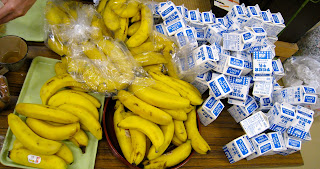あけましておめでとございます!!!!Happy New Year!
New Years in Japan ... wow, where to start. There are many customs and traditions during the New Year Holidays in Japan. I will try my best to convey some that I have been lucky enough to experience with my Okinawan Family. The feelings and sentiment around New Years in Japan is quite similar to that of Christmas for my family and I in Canada. To put it simply - Food, Family, Fun!

[ Kagami Mochi - 鏡餅 ]
Above is a decoration seen during the New Year called
Kagami Mochi. It is filled with Mochi (rice cake) and is topped with an Orange. Apparently the Mochi is broken down and eaten on the second Saturday or Sunday January.

[ New Years Decorations ]

[ Table Decoration ]

[ Kagami Mochi - 鏡餅 ]
2010 is the year of the Tiger. This is my tiny but cute New Years Decoration.

[ Oseibo - お歳暮 ]
Gift giving is very important in Japanese Culture. Above is a picture of the Oseibo that I gave this Winter. A person gives Oseibo to people/families that they have a relationship with, especially those that have helped that person. This year I gave Oseibo to my Okinawan Family and to the family that I lived with when I first came to Okinawa (Kinjo Family).
On New Years Eve, there is no Countdown to midnight or anything. Usually, families will hang out and eat Toshi-Koshi Soba (literally year-crossing soba) and watch NHK's Kohaku Uta Gassen (Red vs. White Singing Contest) one of Japans most watched television programs.

[ Toshi-Koshi Soba ]
Gifts of Money are given to Children on New Years Day. It is called Otoshidama お年玉. It is given in colourful envelopes and usually contains anywhere from 1000 - 10, 000 yen. Even though we are almost 30! A and I both, were lucky enough to receive Otoshidama from A's Dad!

[ Anpan Man Otoshidama ]

[ Lucky Desu!!! ]
New Years Day is when everyone gets together to eat traditional food called
Osechi Ryori. The three boxes have been divided into Japanese Style, Chinese Style and Westernized Style. Most of the dishes are sweet, sour, or dried, in order to keep without refrigeration. This Osechi set was made to order by a hotel. Each box cost more than $100 each. All of the dishes have some sort of symbolism and are thought to bring luck when eaten.

[ Osechi Ryori ]

[ Westernized Osechi Box ]
I was lucky enough to learn how to make a few important dishes from A's Mom. One of those dishes is a special soup eaten at New Years called
Ozoni. This soup has Omochi (rice cake) at the bottom of the bowl. It is served in individual bowls with individual pieces of Mochi. This Ozoni soup had a soup broth made from fish flakes (dashi), and then fresh ingredients are added such as spinach, fish cake, one quail egg, a slice of cooked duck, shitake mushroom, yuzu peel, and mochi.

[ Ozoni Ingredients ]

[ Mochi cooking for the Ozoni ]
The second dish I learned to make is a traditional Okinawan food called San-Mai Niku (三枚肉) which is a thick slice of stewed pork belly, skin and all!!!!! It is actually quite delicious if you can get past the skin and layers of fat.

[ San-Mai Niku - 三枚肉 ]
One very interesting item that we purchased for the New Years celebration was a package of
Whale Meat. I have never seen whale for sale. Apparently it is only available during special times. I did not eat any. I did not see anyone eat any. I was talking with A about it and it really came down to the fact that young people do not usually eat it but that it is a cultural tradition that has been passed down for centuries. A asked me to think about Inuit people in Canada and what kinds of controversial things they eat and why. What do you think?

[ Whale Meat - A Part of the Culture? ]
Along with all of the above foods to eat, A BBQ'd up some Big Country Style Pork Ribs we had bought on the American Military Base, Giant Shrimp, and a half Salmon. The BBQ was unbelievably delicious!

[ The Salmon ready to be BBQ'd ]

[ A's Aunt and Little Baby Cousin ]
Late in the evening on the 1st, we headed out to Futenma
Shrine. As you approach the Shrine there are tons of people out and about, so there are also tons of festival stalls set-up with food/drink, games, and random things to buy.

[ Festival Prizes ]

[ Shrine Torii - Gate ]
At the shrine we gave our offerings and then we each got personal fortunes -
Omikuji (おみくじ) for 2010. If your fortune is good you keep the paper. If it is OK or Not Good then usually people will tie the strip of paper to a tree or metal wires alongside the Shrine. Thus leaving the fortune there rather than attaching to the receiver.

[ Omikuji - おみくじ ]
My fortune was "Very Good" but A suggested that unless it was EXCELLENT I should tie it and leave it at the Shrine.

[ Leaving my Omikuji ]
After all the excitement of the past 2 days I was so exhausted but found the energy to play a few games of BINGO with the family and try out the new Wii Software - Wii Resort Sports with the Motion Plus (Awesome!). I hope you all had an enjoyable New Years! All my best wishes for 2010!!!!!!
Love,
Julie



























































